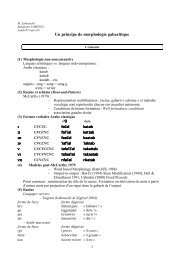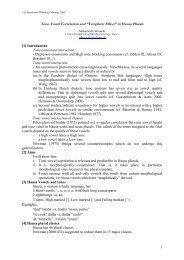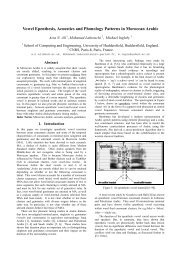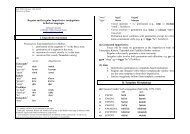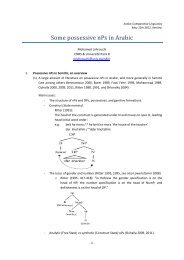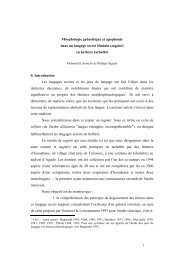Regular and Irregular Imperfective conjugations - Mohamed Lahrouchi
Regular and Irregular Imperfective conjugations - Mohamed Lahrouchi
Regular and Irregular Imperfective conjugations - Mohamed Lahrouchi
Create successful ePaper yourself
Turn your PDF publications into a flip-book with our unique Google optimized e-Paper software.
<strong>Regular</strong> <strong>and</strong> <strong>Irregular</strong> <strong>Imperfective</strong> <strong>conjugations</strong><br />
in Berber languages<br />
In Berber languages, the <strong>Imperfective</strong> stem is formed by means of: (i) prefixation of<br />
the augment /tt-/ to the basic stem, (ii) gemination of a segment in the stem <strong>and</strong> (iii) insertion<br />
of a vowel in the stem. Vowel insertion may operate with /tt-/ prefixation (e.g. xdm ⇒<br />
ttxdam “work”) or with gemination (e.g. gn ⇒ ggan “sleep”) whereas prefixation never<br />
combines with gemination, except for a few mono-consonantal verbs (e.g. g ⇒ ttgga “be”).<br />
In this paper, regular <strong>and</strong> irregular verbs are contrasted within a Template Morphology<br />
Model. The aim is to show that both types of verbs involve a set of morphological operations<br />
that follow from templatic constraints. Thereafter, focus will be made on irregular verbs. It<br />
will be shown that the surface irregularity which they display across Berber languages hides a<br />
templatic activity that makes them somewhat “underlyingly” regular.<br />
In the <strong>Imperfective</strong> stem, irregular verbs differ from regular ones in that they undergo<br />
more than one morphological operation. Examples from Tamazight, Tamashek <strong>and</strong> Tashlhiyt<br />
Berber varieties * @@<br />
follow under [1]:<br />
[1]<br />
a) Tamazight<br />
Aorist <strong>Imperfective</strong><br />
“get cold” kr´m k´rr´m<br />
“pierce” gbu g´bbu<br />
“overnight” n´s n´ssa<br />
“be” g t´gga / tt´g<br />
“wash”<br />
b) Tamashek<br />
´gW t´ggWa<br />
“do” Q$j tA@jj(a)<br />
“hit” ´@w´t t´wwA@t<br />
“say” Q$nn jA@nn<br />
“kill”<br />
c) Tashlhiyt<br />
Q$NF nA@qq<br />
“st<strong>and</strong> up” nkr nkkr<br />
“sleep” gn ggan<br />
“be, become” g ttgga<br />
“eat” SS Stta<br />
“hit” ut kkat<br />
Traditionally, Berber linguists who examined this kind of formation were often<br />
discouraged by the number <strong>and</strong> the nature of the operations used to derive the <strong>Imperfective</strong><br />
forms. Notice that within a Prosodic Morphology Model (McCarthy & Prince 1986 et seq.),<br />
most of the mono- <strong>and</strong> bi-consonantal inputs given in [1] violate the Minimality Word<br />
Constraint. Different kinds of verbs are distinguished in [1]:<br />
(i) verbs geminating only one stem consonant (e.g. Tamazight: k´rr´m, g´bbu;<br />
Tashlhiyt: nkkr, knnu).<br />
(ii) Verbs using both gemination <strong>and</strong> vowel insertion (e.g. Tamashek: nA@ @qq;<br />
Tamazight: n´ssa; Tashlhiyt: ggan)<br />
(iii) Verbs using affixation <strong>and</strong> vowel insertion (e.g. Tamazight: tt´g, Tashlhiyt Stta)<br />
* Tamazight, Tamashek <strong>and</strong> Tashlhiyt are spoken in the Middle Atlas range in Morocco, Mali <strong>and</strong> Southwest of<br />
Morocco, respectively.
(iv) Verbs using affixation, vowel insertion <strong>and</strong> gemination (e.g. Tamazight: t´gga,<br />
t´ggWa; Tamashek: t´wwA@ @@ @t, tA@ @@ @jj(a); Tashlhiyt: ttgga)<br />
Many linguists talk about lexical idiosyncrasy since some verbs change completely<br />
(e.g. Tashlhiyt: ut ⇒ kkat) while others use unusual infixes (e.g. Tamashek: Q$ $$ $nn ⇒ jA@ @@ @nn,<br />
Tashlhiyt: SS SS ⇒ Stta). My claim will not concern the origin of such affixes. Rather, I will<br />
show that the shape -more particularly, the size- of the <strong>Imperfective</strong> form depends on the<br />
Aorist form. That is, the shorter the Aorist form is, the more numerous the operations used to<br />
transform the verb are. Indeed, a triconsonantal verb merely geminates the medial consonant<br />
at the <strong>Imperfective</strong> stem while bi- <strong>and</strong> mono-consonantal verbs undergo both gemination <strong>and</strong><br />
affixation. In any cases, the imperfective form is nothing but an extended aorist form;<br />
gemination, affixation <strong>and</strong> vowel lengthening are different ways that makes it possible for any<br />
input to extend its stem. Therefore, I suggest that the imperfective forms in [1], though being<br />
morphologically different, are “templatically” similar: they are derived by means of a unique<br />
template as given in [2]:<br />
[2] CVCVCVCV<br />
In the case of tri-consonantal verbs, the template in [2] is filled by the three stem<br />
consonants <strong>and</strong> the underlined CV is an empty site where the medial consonant gets<br />
geminated. This is illustrated in [3] with the imperfective form k´rr´m:<br />
[3]<br />
CVCVCVCV<br />
| | \ | | |<br />
k ´ r ´ m<br />
On the other h<strong>and</strong>, Berber peripheral vowels (u, a, A, i) are represented, following<br />
Lowenstamm (1991), Bendjaballah (2000) <strong>and</strong> Idrissi (2000), as being phonologically long:<br />
they are connected with two V slots. By contrast, central vowels (´,Q) are short: they are<br />
connected with one V slot. This allows verbs like g´bbu <strong>and</strong> n´ssa to get their template filled.<br />
The surface irregularity that mono- <strong>and</strong> bi-consonantal verbs display in the<br />
<strong>Imperfective</strong> stem is due to the fact that they use the same template as tri-consonantal verbs.<br />
Therefore, they must use all the operations they can in order to fill a template that contains<br />
four CV units. For example, a short verb like g undergoes both prefixation, gemination <strong>and</strong><br />
vowel insertion to get the <strong>Imperfective</strong> template filled, while a verb like kr´m merely<br />
undergoes gemination. Here below are represented some of the irregular imperfective forms<br />
given in [1]:<br />
[4]<br />
CVCVCVCV CVCVCVCV CVCVCVCV<br />
| | \ / \ / \ / \ / | | \ / \ /<br />
t ´ g a [t´gga] k a t [kkat] n A q [nA@qq]<br />
The templatic approach as suggested here is not limited to Berber languages.<br />
Examples will be given from other Afroasiatic languages such as Classical Arabic (Guerssel<br />
& Lowenstamm 1993), Akkadian, Geez <strong>and</strong> Somali.<br />
References:<br />
Bendjaballah, S. 2001. The « negative preterite » in Kabyle Berber. Folia Linguistica XXXIV/3-4 :185-220.<br />
Guerssel, M. & Lowenstamm, J. The Derivational Morphology of the Classical Arabic Verbal System. ms. UQAM<br />
& Université Paris 7.<br />
Idrissi, A., 2000. On Berber plurals. In J. Lecarme, J. Lowenstamm & U. Shlonsky (Eds.), Research in<br />
Afroasiatic Grammar, Benjamins, Amsterdam.
Lowenstamm, J. 1991. Vocalic Length <strong>and</strong> Centralization in Two Branches of Semitic (Ethiopic <strong>and</strong><br />
Arabic). In. A.S. Kaye (ed.), Semitic Studies in honor of Wolf Leslau on the occasion of his eighty-fifth birthday.<br />
Wiesbaden: Otto Harrassowitz, 949-965.<br />
Lowenstamm, J., 1996. CV as the only syllable type. In. J. Dur<strong>and</strong> & B. Laks (Eds.), Current Trends in<br />
Phonology : Models <strong>and</strong> Methods: 419-441. CNRS, ESRI, Paris X.<br />
McCarthy, J. <strong>and</strong> A. Prince (1986) Prosodic Morphology, ms. Univ. of Massachusetts <strong>and</strong> Br<strong>and</strong>eis Univ.<br />
<strong>Mohamed</strong> <strong>Lahrouchi</strong><br />
UMR 7023- Structures Formelles du Langage<br />
CNRS-Université Paris 8<br />
15, rue Catulienne<br />
93200 Saint-Denis, France.<br />
E-Mail : mohamed.lahrouchi@univ-paris8.fr



